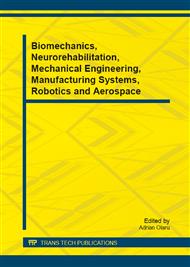[1]
H. G. Elias, An Introduction to Plastics, 2nd ed., Wiley-VCH GmbH & Co.KGaA, Weinheim, 2003.
Google Scholar
[2]
J. Golebiewskia, A. Galeski, Thermal stability of nanoclay polypropylene composites by simultaneous DSC and TGA, Comp. Sc. and Tech. 17 (2007) 3442-3447.
DOI: 10.1016/j.compscitech.2007.03.007
Google Scholar
[3]
Y. S. Thio, A. S. Argon, R. E. Cohen, M. Weinberg, Toughening of isotatic polypropylene with CaCO3 particles, Polymer 43 (2002) 3661-3674.
DOI: 10.1016/s0032-3861(02)00193-3
Google Scholar
[4]
S. Zokaei, R. Lesan-Khosh, R. Bagheri, Study of scratch resistance in homo- and co-polypropylene filled with nanometric calcium carbonate, Mat. Sc. and Eng. A, 445 (2007) 526-536.
DOI: 10.1016/j.msea.2006.09.080
Google Scholar
[5]
Z. Demjen, B. Pukanszky, J. Nagy, Evaluation of interfacial interaction in polypropylene/ surface treated CaCO3 composites, Composites 29A (1998) 323–329.
DOI: 10.1016/s1359-835x(97)00032-8
Google Scholar
[6]
P. Hutař, Z. Majer, L. Náhlík, L. Šestáková, Z. Knésl, Influence of particle size on the fracture toughness of a PP-based particulate composite, Mech. of Comp. Mat. 45 (2009) 281-286.
DOI: 10.1007/s11029-009-9085-6
Google Scholar
[7]
S. M. Zebarjad, M. Tahani, S. A.Sajjadi, Influence of filler particles on deformation and fracture mechanism of isotactic polypropylene, J. of Mat. Proc. Tech. 155 (2004) 1459-1464.
DOI: 10.1016/j.jmatprotec.2004.04.187
Google Scholar
[8]
Z. Majer, P. Hutař, Z. Knésl, Crack behaviour in polymeric composites: The influence of particle shape, Key Eng. Mat. 465 (2011) 564-567.
DOI: 10.4028/www.scientific.net/kem.465.564
Google Scholar
[9]
F. N. Ahmad, M. Jaafar, S. Palaniandy, K. A. M. Azizli, Effect of particle shape of silica mineral on the properties of epoxy composites, Comp. Sc. and Tech. 68 (2008) 346-353.
DOI: 10.1016/j.compscitech.2007.07.015
Google Scholar
[10]
J. Leidner, R. T. Woodhams, The strength of polymeric composites containing spherical fillers, J. of Appl. Pol. Sc. 18 (1974) 1639–1654.
DOI: 10.1002/app.1974.070180606
Google Scholar
[11]
M. DeSarkar, P. Senthilkumar, S. Franklin, G. Chatterjee, Effect of Particulate Fillers on Thermal Expansions and Other Critical Performances of Polycarbonate-Based Compositions, J. of Appl. Pol. Sc. 124 (2011) 215-226.
DOI: 10.1002/app.33667
Google Scholar
[12]
R. N. Rothon, Particulate-Filled Polymer Composites, 2nd ed., Rupra Technology Limited, Shrewsbury, 2003.
Google Scholar
[13]
I. L. Dubnikova, V. G. Oshmyan, A. Y. Gorenberg, Mechanisms of particulate filled polypropylene finite plastic deformation and fracture, J. of Mat. Sc. 32 (1997) 1613–1622.
Google Scholar
[14]
O. K. Muratoglu, A. S. Argon, R. E. Cohen, M. Weinberg, Toughening mechanism of rubber-modified polyamides, Polymer 36 (1995) 921–930.
DOI: 10.1016/0032-3861(95)93590-i
Google Scholar
[15]
A. R. Katritzky, R. Sakhuja, L. Huang, R. Gyanda, L. Wang, D. C. Jackson, D. A. Ciaramitaro, C. D. Bedford, R. S. Duran, Effect of Filler Loading on the Mechanical Properties of Crosslinked 1,2,3-Triazole Polymers, J. of App. Pol. Sc. 118 (2010) 121-127.
DOI: 10.1002/app.32257
Google Scholar
[16]
R. Pal, New models for effective Young's modulus of particulate composites, Comp. Part B: Engin. 36 (2005) 513-523.
DOI: 10.1016/j.compositesb.2005.02.003
Google Scholar
[17]
G. V. Kozlov, Yu. S. Lipatov, Change in the structure of polymer matrix of particulate-filled composites: The fractal treatment, Mech. of Comp. Mat. 40 (2004) 545-550.
DOI: 10.1007/s11029-005-0026-8
Google Scholar
[18]
Z. Majer, L. Náhlík, P. Hutař, The estimation of micro-crack behavior in polymer particulate composite with soft interphase, Adv. Mat. R. 482-484 (2012) 1660-1663.
DOI: 10.4028/www.scientific.net/amr.482-484.1660
Google Scholar
[19]
Z. H. Liu, K. W. Kwok, R. K. Y. Li, C. L. Choy, Effects of coupling agent and morphology on the impact strength of high density polyethylene/CaCO3 composites. Polymer 43 (2002) 2501-2506.
DOI: 10.1016/s0032-3861(02)00048-4
Google Scholar
[20]
Z. Majer, P. Hutař, The effect of nonlinear matrix on crack propagation in the particulate composite, Key Eng. Mat. 488-489 (2012) 484-487.
DOI: 10.4028/www.scientific.net/kem.488-489.484
Google Scholar
[21]
G. Levita, A. Marchetti and A. Lazzeri, Fracture of ultrafine calcium carbonate/polypropylene composites, Polym. Comp. Vol. 10 (1989) 39–43.
DOI: 10.1002/pc.750100106
Google Scholar
[22]
B. Pukánszky, Interfaces and interphases in multicomponent materials: past, present, future, Eur. Pol. J. 41 (2005) 645-662.
DOI: 10.1016/j.eurpolymj.2004.10.035
Google Scholar
[23]
S. Y. Fu, X. Q. Feng, B. Lauke, Y. W. Mai, Effects of particle size, particle/matrix interface adhesion and particle loading on mechanical properties of particulate–polymer composites, Composites: Part B 39 (2008) 933–961.
DOI: 10.1016/j.compositesb.2008.01.002
Google Scholar
[24]
M. Kozak, A. Danch, W. Osoba, L. Domka, F. Stelzer, S. Jurga, Relationship between filler loading and morphology of the interphase in polyethylene-chalk composites, Polym. and Polymer Comp. 12 (2004) 409-416.
DOI: 10.1177/096739110401200505
Google Scholar
[25]
W. C. J. Zuiderduin, C. Westzaan, J. Huétink, R. J. Gaymans, Toughening of polypropylene with calcium carbonate particles, Polymer 44 (2002) 261-275.
DOI: 10.1016/s0032-3861(02)00769-3
Google Scholar
[26]
Z. Majer, E. Novotná, The effect of various non-linear matrix types on mechanical properties of particulate composite, Chemické listy 105 (2011) 830-831.
Google Scholar
[27]
E. Molliková, The relationship between production technology, structure and mechanical properties of polypropylene filled with magnesium hydroxide [in czech], Ph.D. thesis, Brno (2003).
Google Scholar
[28]
F. Erdogan, G. C. Sih, On the Crack Extension in Plates under Plane Loading and Transverse Shear, J. of Basic Eng. 85 (1963) 519-527.
DOI: 10.1115/1.3656898
Google Scholar
[29]
G. M. Kim, G. H. Michler, Micromechanical deformation processes in toughened and particle-filled semicrystalline polymers: part1,2, Polymer 39 (1998) 5689-5703.
DOI: 10.1016/s0032-3861(98)00169-4
Google Scholar


